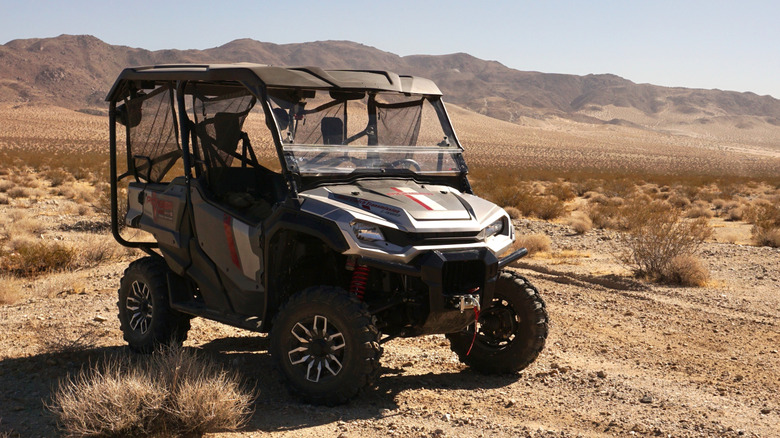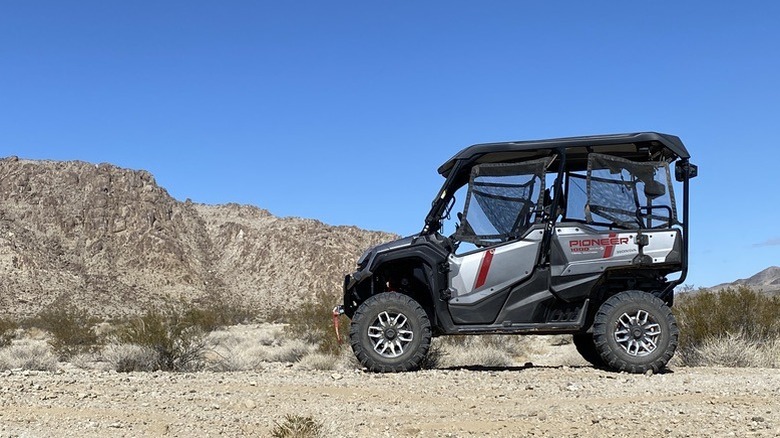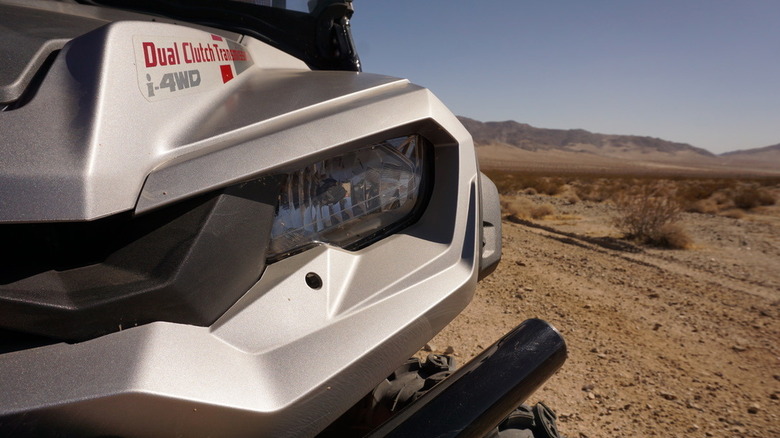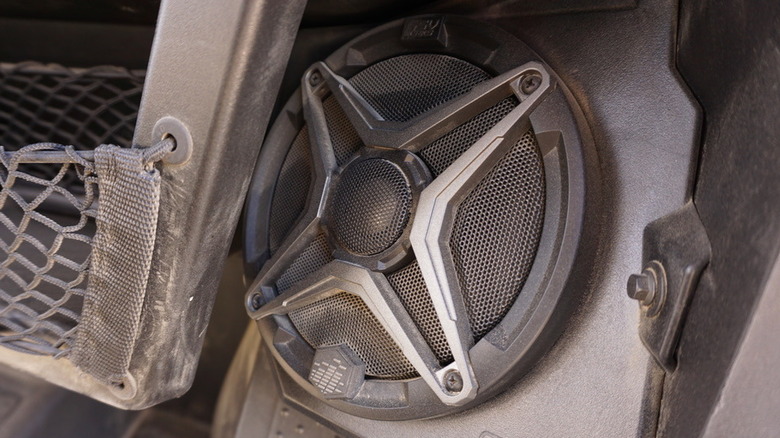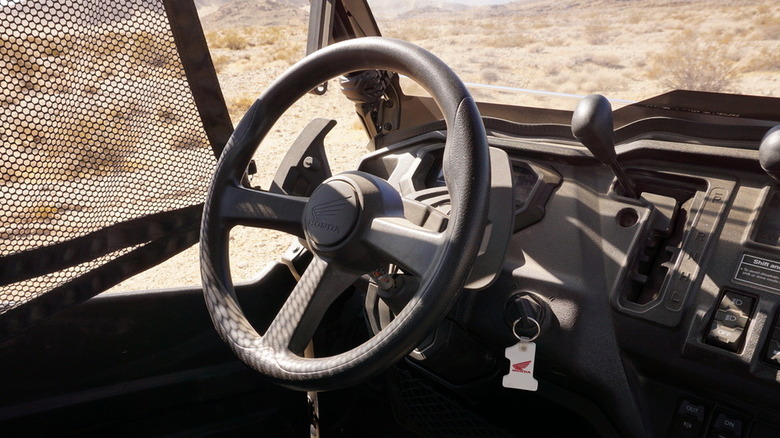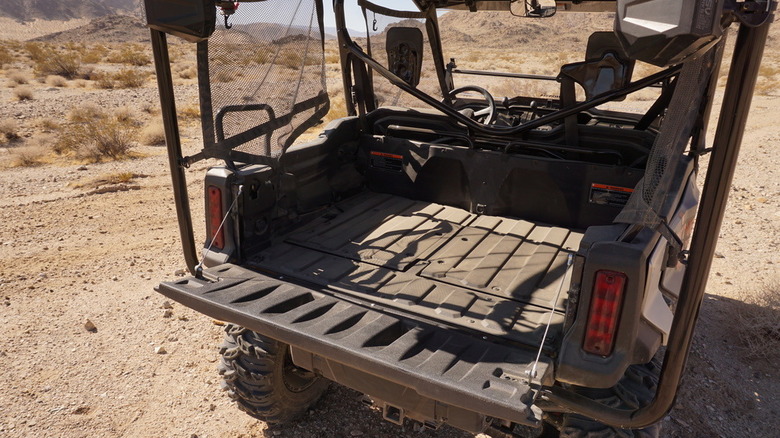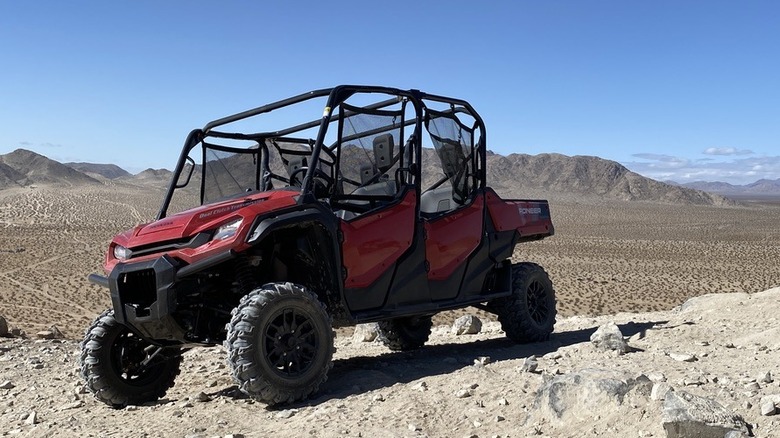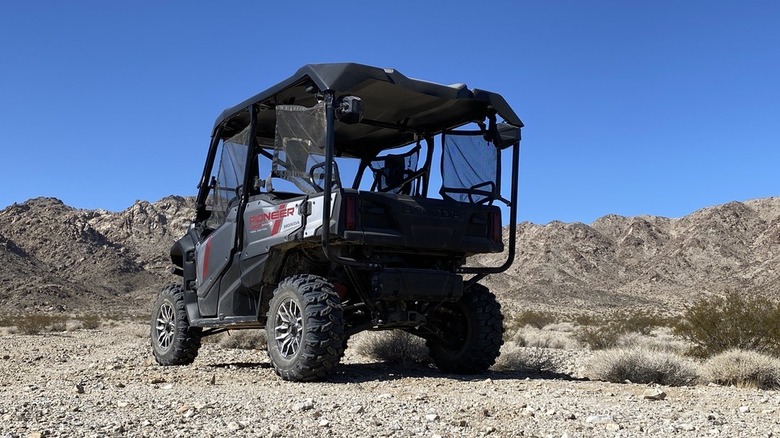2025 Honda Pioneer 1000-5 First Drive: Trail Special Edition Is Capable But Costly
Utility side-by-sides like the Honda Pioneer offer impressive off-road capability, enough power to tow small trailers, and a pretty reasonable amount of equipment for the money. Sure, at over $20k, something like the Pioneer 1000-5 isn't exactly cheap, and it doesn't offer creature comforts like heated seats, but it can tackle some very specific tasks.
Recently, I had the chance to drive a few different Pioneer's around California's desert as the King of the Hammers was taking place all around me. There were all sorts of off-road races, insane hill climbs, and debauchery going on in the background, but I was out on trails enjoying the scenery in the Pioneer, experiencing the what the utility side-by-side had to offer. The 1000-5, the side-by-side workhorse that I got to test out, is one of the largest and most powerful of Honda's side-by-side vehicles currently available, combining practicality and playfulness all in one package.
Pricing out the Pioneer
There are lots of different versions of the Pioneer, differing in engine, seating, and of course price. First, there are a few different engine sizes to choose from: the 520, the 700, and the 1000. The 520 is the smallest of the bunch, only available in a two-seater configuration and powered by a 518cc single-cylinder engine; base price for a Pioneer 520 is $11,384 (including $885 destination fee). The Pioneer 700 uses a 675cc single-cylinder engine, and bumps pricing up to $13,684 (including $1,185 destination fee) on two-seater models. Pioneer 700 four-seaters have a starting price of $15,184.
At the top of the Pioneer range is the 1000, which uses a 999cc parallel-twin engine. Like the 700, the Pioneer 1000 is available in multiple seating configurations; the 1000, however, is big enough to accommodate as many as six passengers. The standard three-seat Pioneer 1000 starts at $18,894 (including $1,295 destination). Want to add that second row of seating and increase capacity to five passengers? The Pioneer 1000-5 has a starting price of $20,294. The six-passenger model, known as the 1000-6 Deluxe Crew, starts at $23,594 (including $1,395 destination fee).
Behind the wheel of the 1000-5 Trail Special Edition
The Pioneer 1000-5 I drove in the desert comes in three trims: EPS, Deluxe, and Trail Special Edition. At $27,894 (including $1,295 destination fee) the new-for-2025 Trail Special Edition is much pricier than the standard model, but it also has a lot of extra equipment worth checking out, so that's the one I spent the most time with.
Like the other versions of the Pioneer 1000, the TSE has 2,500 pounds of towing capacity and 1,000 pounds of bed capacity (600 pounds for California vehicles). That's certainly enough to be a useful tool on any farm, or towing around small equipment on large ranches.
A dual-clutch transmission (DCT) is standard, along with four-wheel drive, four-wheel disc brakes, a winch, and electric power steering. The result is a sure-footed side-by-side that's easy to drive off-road. On steep trails, with unstable rocks and lots of sand, the Pioneer felt stable. The OTR Dirt Master tires kept me on track, even when I forgot to engage four-wheel drive a few times. On open-desert trails, the Pioneer felt tough and well-built: large ruts and rocks were shrugged off with ease, and none of the panels creaked or moaned across the uneven surfaces. The Pioneer might be a utility side-by-side, but it can handle some seriously rough terrain.
More equipment worth testing out
On top of the standard equipment, the TSE comes with a roof and a two-piece windscreen, both of which are helpful when you're trying to hide from the elements like rain or harsh desert sun. The bottom of the windscreen hinges and opens forward, allowing for some air flow while keeping the wind off your face directly. It's not exactly air-conditioning, but it's a nice feature worth having if you spend a lot of time in the desert heat.
According to Honda, this is the first four-wheel powersports vehicle they've produced that has a stereo installed from the factory. This stereo–which is weatherproof and uses five speakers including a 10-inch under-seat subwoofer–provided better sound than I'd expect from a utility vehicle like the Pioneer. Volume was adequate enough to hear over the noises of the desert and through my helmet. Audiophiles won't exactly swoon over it, but it's an upgrade I'd opt for.
Doors, side mirrors, bumper guards, a bed extender, and all sorts of exterior lights are also available for buyers that want to add a bit of customization to their rig.
Adequate but not stunning power
Power in the Pioneer feels decent–Honda won't disclose exact horsepower figures for its side-by-side models–but it's not a vehicle I would describe as fast. Sure, the 999cc parallel twin gives you all the brappy noises you expect with a desert backdrop, but the grunt is modest at best. Thankfully, the side-by-side is light enough that even modest power makes it entertaining to drive. Curb weight for the 1000-5 TSE checks in at 1,777 pounds (1,781 for California models) which makes it the heaviest of the 1000-5 trims, but it still felt maneuverable on tight trails, with light steering.
The DCT shifts quickly and at appropriate points in the powerband. Crawling up mountains, cruising across small whoops and washboard roads, and stretching the Pioneer's legs across the desert were all experiences where I let the DCT do its thing. Only when the going got a bit tough, or the curves in the desert side-by-side footprints got a bit tight, did I start changing the gears myself. The paddle shifters are large, easy to engage with, and have a relatively quick response time when it comes pulling one to change gear. For something with utility as its main priority, it put a pretty big smile on my face.
Hard work, made easy
The Pioneer is the kind of vehicle you can get in, look out across the desert, and select your destination without worrying whether or not you can make it there. I'd probably pick an area with more trees, but my personal preference of landscape makes no difference to the Pioneer. The TSE has the smallest amount of ground clearance of any version of the Pioneer 1000-5 and yet it still checks in at 12.3 inches – a hefty height indeed. Short of boulders and sheer cliff faces, there isn't much that will keep you from getting to your destination.
I imagine shoppers for utility side-by-sides like this as winery owners, back-country homesteaders, or ranchers; all would get a ton of use out of the Pioneer 1000-5. Maybe buyers can't fit an SUV down the narrow trails on their property, so they use a utility side-by-side instead. Or, maybe they want something that can pull out the occasional tree stump while serving weekend duty as a transport for gardening equipment. Got a mailbox that's a mile from your front door and there's a creek to cross on your commute? No problem: the Pioneer has you covered.
The Pioneer 1000-6 Deluxe Crew seats six
After some time in the Pioneer 1000-5, Honda tossed me the keys to the bigger model: the six-passenger 1000-6 Deluxe Crew. It uses the same 999cc engine as the five-passenger Pioneer, but it has benches for three-wide seating in both the front and the rear. While there's slightly less suspension travel than the five-passenger model, Honda offers self-leveling rear suspension, a feature that the 1000-5 doesn't get. The rear seats are staggered to keep passengers from butting shoulders, and there's plenty of room in both rows for adults on short trips.
The 1000-6's tilting rear bed is another benefit worth noting, with a hydraulic assist that helps you dump the contents wherever they're needed. Dynamically, I couldn't feel much of a difference when driving the 1000-5 Pioneer versus the 1000-6. The 1000-6 weighs a bit more (1,936 lbs) but power from the parallel twin feels just as adequate, and most of the hardware that underpins both models is the same. If you've got a regular need for transporting passengers over any meaningful distance, this is the Pioneer that you'll want to check out.
2025 Honda Pioneer 1000-5 Verdict
After a few hours piloting both versions of the Pioneer, I was thinking of totally irrational excuses to buy one for myself. I live in the middle of Los Angeles, far from trails and I certainly don't have property that would necessitate the utility these side-by-sides provide, but that didn't stop me from dreaming. Maybe I could keep one nearby in case of a tsunami? What if a zombie apocalypse really does happen? I'd totally need one of these in that scenario, right?
Rationality of ownership aside, my time in the Pioneer gave me the impression that it's an entertaining tool to explore the desert with, and it makes a good case for itself as a utility platform. I'd love to have the garage space to accommodate something as capable and fun. The Honda is a bit down on power, but that didn't dampen the experience much. Rivals to consider include the Polaris Ranger (the XPedition is a bit more expensive) and the Can-Am Defender, which comes in a dizzying array of configurations if you're looking to customize your experience. There's also the Kawasaki Ridge and the Yamaha Viking family of side-by-sides, although the Yamaha is a better match to the Pioneer 700 in terms of pricing and capability.
